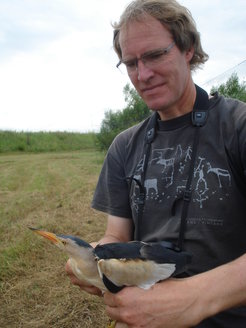“We still know far too little about bird flu”
Wolfgang Fiedler, an ornithologist at the Radolfzell Ornithological Station, pleads for more research leading to a better understanding of transmission paths
Bird flu continues to spread in Germany: 13 federal states are now affected. The H5N8 virus mainly affects wild birds and poultry stocks. In the last four weeks alone, the authorities have reported 16 outbreaks throughout Germany in poultry and bird holdings, four of which occurred in zoos. The virus has now been detected in 12 European states and H5N8 cases have also been reported in India, Iran, Tunisia and Egypt. Consequently, epidemiologists are already talking about a pandemic among wild birds.

Mr Fiedler what is the current situation in the Lake Constance area?
Wolfgang Fiedler: We are working closely with around 150 ornithologists in the region. They have counted around 900 dead birds in the Lake Constance area up to now. This is significantly higher than the number reported during the last H5N1 outbreak ten years ago. However, given that over 200,000 aquatic birds are wintering in the area, we are not worried about the wild populations at present. Their stocks are not at risk from the bird flu.
Which species are mainly affected?
Around three quarters of the dead birds are tufted ducks. They are very sensitive to infection and usually die within a matter of hours. For this reason it is very unlikely that the diseased birds would fly over one thousand kilometres and introduce the infection here in this way. Pochards, which are very closely related to the tufted ducks, are also dying from bird flu but in far fewer numbers – similarly, mute swans, great crested grebes and Eurasian coots, which tend to be more robust and far less likely to be severely affected by the disease.
How likely do you consider that the virus could be transmitted through infected feed?
In my view this claim is largely based on unverified conspiracy theories.
There are numerous theories circulating on the internet at the moment suggesting that outbreaks of bird flu are being hushed up by the poultry industry. Individual scientists also believe that poultry from farms within Germany could have infected wild animals with the virus, for example via the spreading of manure from poultry farms as a fertiliser. This may be basically conceivable, but it does not explain what is happening at the moment. Poultry manure is not spread as a fertiliser in the Lake Constance area, nonetheless we are seeing numerous infected wild birds.
The situation in relation to long-distance transport is different; because Germany exports chicken meat and chickens to Asia every year, in the case of poor hygiene standards, transport workers and transport containers can come into contact with the virus and introduce the infection to Europe in this way.
This transmission path cannot be excluded, but it is unlikely that it can provide a full explanation for the epidemic within Europe. Like me, many scientists believe that poultry stocks can be infected by wild birds. Species like the mallard duck, which can carry the virus without becoming seriously ill themselves, would be the main culprits here.
How exactly does this work?
The current bird flu outbreak originated in south-east Asia. The H5N8 virus was also discovered here for the first time. It is not yet possible provide a complete explanation as to how the virus was transported over the long distance from there to Europe. Many facts are still unknown here and require further investigation.
What is known is that mallard ducks often carry type A influenza viruses, an acknowledged cause of bird flu, in a low pathogenic form. This means that the ducks do not contract the disease themselves or only a very mild version of it.
When the bird flu virus was detected in mid-October in Poland and Hungary, mallard ducks or very closely related duck species may then have transmitted it to Germany.
The ICARUS project, which is due to start next April, will involve fitting wild animals throughout the world with transmitters monitored by the International Space Station ISS.
Together with my boss Martin Wikelski and other colleagues from the Max Planck Institute for Ornithology, we aim to gain a better understanding of the migration of wild ducks from Siberia. For this reason we will fit numerous ducks with mini-transmitters and in this way find out more about the migration behaviour of Siberian ducks. Along with other projects, this will be one of the first research ventures on the ISS and will definitely provide us with new information on the spreading of bird flu. The ducks only take a few days to travel from the Urals to the Baltic Sea.
Unlike the H5N1 virus, this year’s bird flu is not harmful to humans. So what precautions should bird lovers take nonetheless?
Not every dead bird we find in nature at the moment died of bird flu. Up to now only chickens and aquatic birds like ducks, swans, geese and seagulls have been affected. Songbirds at bird feeders are very rarely affected by this disease. And if this happens, they excrete so few viruses in their faeces that they cannot be considered carriers of the disease. Therefore, caution should only be exercised with regard to contact with the aforementioned aquatic birds.
It is best to avoid direct contact with dead animals and to report any finds directly to the relevant regional veterinary service, which will carry out a detailed examination of the cadaver. It is also important to avoid contributing to the accidental spreading of the virus via dirty shoes or clothing. Gloves should always be worn when cleaning feeders and hands and forearms should be washed thoroughly afterwards.
Thank you very much for the interview and tips!
The interview was conducted by Barbara Abrell












